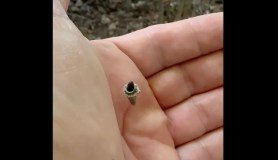If you’re pretty sure your dying houseplant is trying to tell you something — well, you might not be that far off. Israeli researchers just released a study showing that plants actually do make sound when they’re stressed.
Videos by Outdoors
The sounds, which can only be heard with an ultrasonic microphone, resemble quiet “pops” or clicks. The researchers found that whenever they cut a plant, under-watered it, or otherwise subjected it to stress, the plant would start popping more frequently—almost like it was whimpering.
The sounds “might be their version of a call for help,” The Washington Post concluded.
To gather enough convincing evidence, the researchers tested a wide range of plant species over a period of six years. Their test subjects included tomato plants, cacti, tobacco plants, and grape vines, among others. Different plants seemed to speak different languages; each species had its own frequency and volume of pops.
Plants communicate in other ways
While the findings of the experiment were pretty novel, they shouldn’t come as too much of a surprise. After all, plants communicate their stress in plenty of other ways.
When subjected to insects or drought, many trees send signals through their roots or through underground systems of fungi. Other leafy plants emit certain gases. The gaseous chemicals provide a form of communication, signaling to other plants that there may be an incoming threat. When a sick plant releases these chemicals, neighboring plants begin amping up their internal defenses to prepare for the potential pathogen. (Some of these gases may also help boost human immune systems.)
Even more interesting: “Plant vibrations have been described in several scenarios,” the study adds. “Plants exposed to drought stress have been shown to experience cavitation — a process where air bubbles form, expand and collapse [in their tissue], causing vibrations.”
The ultrasonic sounds are caused by a similar process: the popping of tiny air bubbles within a plant’s tissue.

Are they really crying for help?
So, what’s the point of plant speech? It’s possible that some animals, like bats and mice, can hear these sounds, reports Scientific American. Other research has also found that plants seem to “hear” and respond to certain animal sounds. This research suggests that ecosystems may communicate in ways beyond human comprehension.
In the meantime, it’s hard to say whether the plants are “intentionally” using the sounds to communicate with one another. It might be more likely that the sound is just an odd side effect of physiological changes that happen within a stressed plant. So, at this point, the “cry for help” theory is a bit of an exaggeration. (Though, those of us who struggle to keep a houseplant alive will certainly find that it resonates.)
Even so, this research is just the beginning, the scientists say. As they conduct more experiments, they might discover even more complexity in plant communication. So, don’t give up on that houseplant just yet. You never know what it might be trying to tell you.









